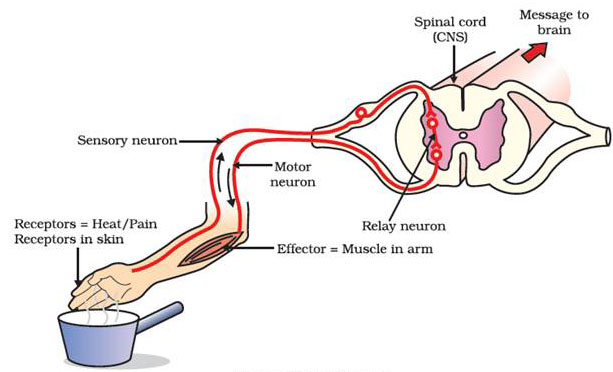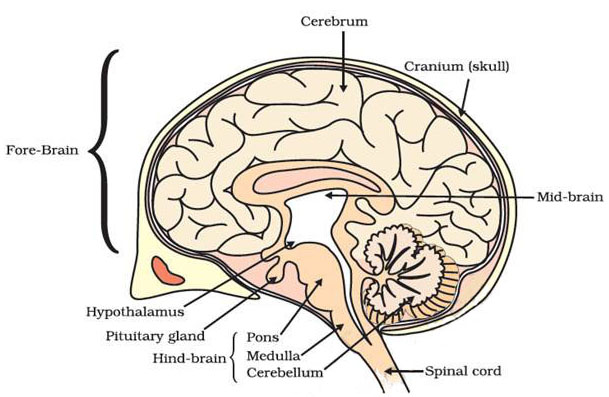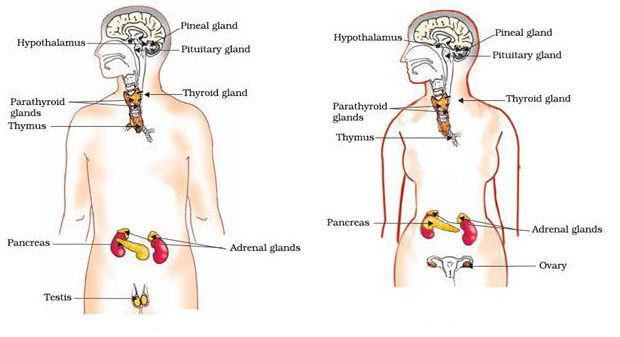The life processes involved in the maintenance functions in living organisms and it need some controls and co-ordinations between organisms.
Some of these movements are in fact the result of growth, as in plants. A seed germinates and grows, and we can see that the seedling moves over the course of a few days, it pushes soil aside and comes out. But if its growth were to be stopped, these movements would not happen. Some movements, as in many animals and some plants, are not connected with growth. A cat running, children playing on swings, buffaloes chewing cud – these are not movements caused by growth.
In animals, such control and coordination are provided by nervous and muscular tissues. Like touching a hot object is an urgent and dangerous situation for us. We need to detect it, and respond to it.
All information from our environment is detected by the specialized tips of some nerve cells. These receptors are usually located in our sense organs, such as the inner ear, the nose, the tongue, and so on. So gustatory receptors will detect taste while olfactory receptors will detect smell.
‘Reflex’ is a word we use generally, when we talk about some sudden action in response to something in the environment.
A common idea in all such examples is that we do something without thinking about it, or without feeling in control of our reactions.
Nerves from all over the body meet in a bundle in the spinal cord on their way to the brain. Reflex arcs are formed in this spinal cord itself, although the information input also goes on to reach the brain. Of course, the reflex arcs have evolved in animals because the thinking process of the brain is not fast enough. In fact many animals have very little or none of the complex neuron network needed for thinking. So it is quite likely that reflex arcs have evolved as efficient ways of functioning in the absence of true thought processes.

Spinal cord is made up of nerves which supply information to think about. Thinking involves more complex mechanisms and neural connections. These are concentrated in the brain, which is the main coordinating centre of the body. The brain and spinal cord constitute the central nervous system. They receive information from all parts of the body and integrate it.
The communication between the central nervous system and the other parts of the body is facilitated by the peripheral nervous system consisting of cranial nerves arising from the brain and spinal nerves arising from the spinal cord. The brain thus allows us to think and take actions based on that thinking.
The brain has three such major parts or regions, namely the fore-brain, mid-brain and hind-brain.
The fore-brain is the main thinking part of the brain. It has regions which receive sensory impulses from various receptors. Separate areas of the fore-brain are specialised for hearing, smell, sight and so on. There are separate areas of association where this sensory information is interpreted by putting it together with information from other receptors as well as with information that is already stored in the brain.
The sensation of feeling full is because of a centre associated with hunger, which is in a separate part of the fore-brain.

Many of involuntary actions are controlled by the mid-brain and hind-brain. All the involuntary actions including blood pressure, salivation and vomiting are controlled by the medulla in the hind-brain.
Think about activities like walking in a straight line, riding a bicycle, picking up a pencil. These are possible due to a part of the hind-brain called the cerebellum.
How are these tissues protected?
The organ like the brain, which is so important for a variety of activities, needs to be carefully protected. The brain is contained in a fluid-filled balloon which provides further shock absorption. The vertebral column or backbone which protects the spinal cord.
How does the nervous tissue cause actions?
When the action or movement is to be performed, muscle tissue will do the final job. Muscle cells have special proteins that change both their shape and their arrangement in the cell in response to nervous electrical impulses. When this happens, new arrangements of these proteins give the muscle cells a shorter form.
Animals have a nervous system for controlling and coordinating the activities of the body. But plants have neither a nervous system nor muscles. When a seed germinates, the root goes down, the stem comes up into the air. The directional movement of a seedling is caused by growth. If it is prevented from growing, it will not show any movement. So plants show two different types of movement – one dependent on growth and the other independent of growth.
A chemical, or hormonal, means of information transmission used in animals, if a chemical signal were to be sent as well, it would reach all cells of the body and provide the wide ranging changes needed. This is done in many animals, including human beings, using a hormone called adrenaline that is secreted from the adrenal glands.
Adrenaline is secreted directly into the blood and carried to different parts of the body. The target organs or the specific tissues on which it acts include the heart. As a result, the heart beats faster, resulting in supply of more oxygen to our muscles. The blood to the digestive system and skin is reduced due to contraction of muscles around small arteries in these organs. This diverts the blood to our skeletal muscles. The breathing rate also increases because of the contractions of the diaphragm and the rib muscles.

Such animal hormones are part of the endocrine system which constitutes a second way of control and coordination in our body.
Some important hormones and their functions
|
Hormone |
Endocrine Gland |
Functions |
|
|
1. |
Growth hormone |
Pituitary gland |
Stimulates growth in all organs |
|
2. |
Thyroid gland |
Regulates metabolism for body growth |
|
|
3. |
Insulin |
|
Regulates blood sugar level |
|
4. |
Testosterone |
Testes |
|
|
5. |
|
Ovaries |
Development of female sex organs, regulates menstrual cycle, etc. |
|
6. |
Adrenaline |
Adrenal gland |
|
|
7. |
Releasing hormones |
|
Stimulates pituitary gland to release hormones |
